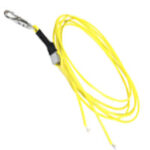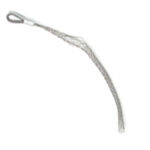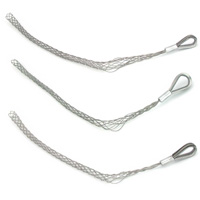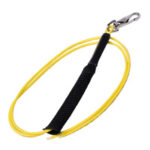Fiber optic cable is surprisingly strong, durable and pliable; however, several best practices should be followed to ensure a successful cable installation.
The below article explores the best practices and tools commonly used to pull fiber optic cable. The Future Ready Solutions Tools & Test Equipment collection explores these solutions in greater detail.
Our News & Insights library is also a wealth of knowledge, and we offer articles that delve deeper into fiber optic termination tools and testers, the difference between different fiber cable constructions, and a variety of other fiber-related topics.
 Pulling Fiber
Pulling Fiber
Most fiber optic cables boast a pull strength of 200+ pounds thanks to the internal kevlar or aramid yarn, known as the strength member.
The most common mistake made when pulling fiber is failing to leverage the strength member. Many installers pull fiber by the outer jacket which is prone to stretch, tear and ultimately break. It’s not uncommon to see an improperly pulled cable’s jacket stretch several meters due to strain placed on the outer jacket, and a stretched jacket won’t provide a secure connector termination thereby compromising the cable’s performance and longevity.
Fiber optic cables should always be pulled by the strengthened yarn fibers inside the outer jacket. This strength member can be exposed by removing a small portion of the jacket with a cable stripper.
Once exposed, the yarn can be looped inside a cable pull-eye and double-backed and taped or knotted for security.
Types of Pulling Tools
Cleerline offers three different types of pulling tools designed for fiber and other low-voltage cables.
Pulling Eye for Duplex and AOCs. The Cleerline SSF-PULLEYED is specifically designed for pulling pre-terminated simplex cables, duplex cables and active optical cables (including models built for HDMI, DisplayPort and USB) provided the connector head fits within the mesh sleeving.
Designed for the real-world rigors of cable installation, the SSF-PULLEYED incorporates PVC-jacketed aramid yarns for strength and a rotating clip to decrease cable twisting during the pull. It’s ideally suited for both running cables in walls or in conduit.
The SSF-PULLEYED is easily reused — simply remove the tape and attach the kit to a new cable.
 Pulling Eye for Multi-Strand Cables & Bundles. The Cleerline SSF-PULLEYEM is specifically designed for pulling multi-strand cables, such as distribution and breakout constructions, and bundles that include multiple different individual cables.
Pulling Eye for Multi-Strand Cables & Bundles. The Cleerline SSF-PULLEYEM is specifically designed for pulling multi-strand cables, such as distribution and breakout constructions, and bundles that include multiple different individual cables.
Like the kit above, the SSF-PULLEYEM incorporates PVC-jacketed aramid yarns for strength and a rotating clip to decrease cable twisting during the pull. However, the SSF-PULLEYEM also features an aluminum locking nut, allowing the cable’s strength member to be attached to the pulling eye. This helps ensure only the strongest part of the cable is under tension.
The SSF-PULLEYEM’s pull sock is constructed of durable plastic mesh to ensure the entire cable bundle is kept secure during the pull.
 Heavy Duty Pulling Sock. The Cleerline Heavy Duty Pulling Sock is available in three different constructions to accommodate non-terminated cables from 7 to 25mm in diameter.
Heavy Duty Pulling Sock. The Cleerline Heavy Duty Pulling Sock is available in three different constructions to accommodate non-terminated cables from 7 to 25mm in diameter.
The pulling socks feature extremely durable wire mesh that supports extra heavy cables, including those built with ruggedized jackets, aluminum interlocking armor and direct burial armor.
Each pulling sock offers a one meter total length for a secure attachment to the cable.
Additional information on these solutions and more is available in the Future Ready Solutions Tools & Test Equipment collection.


